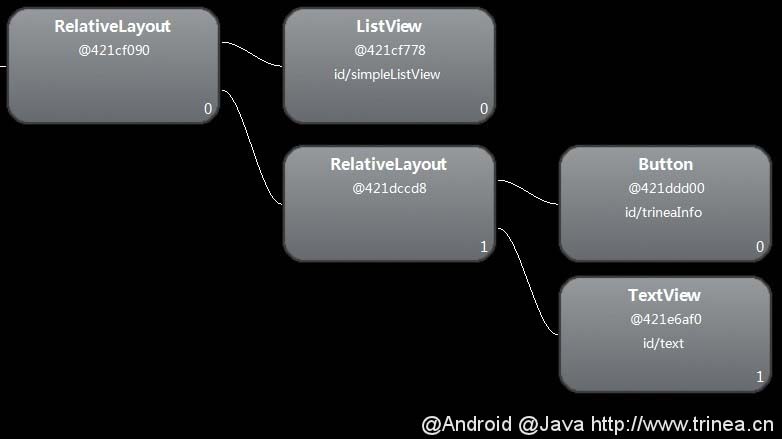Android性能优化之布局优化 Posted 2020-06-17
tags:
篇首语:本文由小常识网(cha138.com)小编为大家整理,主要介绍了Android性能优化之布局优化相关的知识,希望对你有一定的参考价值。
本文为android 使用抽象布局标签(include, viewstub, merge)、去除不必要的嵌套和View节点、减少不必要的infalte及其他Layout方面可调优点,顺带提及布局调优相关工具(hierarchy viewer和lint) 。
目前性能优化专题已完成以下部分:
性能优化总纲——性能问题及性能调优方式
性能优化第四篇——移动网络优化
性能优化第三篇——Java(Android)代码优化
性能优化实例
1、抽象布局标签
(1) <include>标签
1
2
3
4
5
6
7
8
9
10
11
12
13
14
<?xml version="1.0" encoding="utf-8"?>
<RelativeLayout xmlns:android="http://schemas.android.com/apk/res/android"
android:layout_width="match_parent"
android:layout_height="match_parent" >
<ListView
android:id="@+id/simple_list_view"
android:layout_width="match_parent"
android:layout_height="match_parent"
android:layout_marginBottom="@dimen/dp_80" />
<include layout="@layout/foot.xml" />
</RelativeLayout>
其中include引入的foot.xml为公用的页面底部,代码如下:
1
2
3
4
5
6
7
8
9
10
11
12
13
14
15
16
17
18
19
<?xml version="1.0" encoding="utf-8"?>
<RelativeLayout xmlns:android="http://schemas.android.com/apk/res/android"
android:layout_width="match_parent"
android:layout_height="match_parent" >
<Button
android:id="@+id/button"
android:layout_width="match_parent"
android:layout_height="@dimen/dp_40"
android:layout_above="@+id/text"/>
<TextView
android:id="@+id/text"
android:layout_width="match_parent"
android:layout_height="@dimen/dp_40"
android:layout_alignParentBottom="true"
android:text="@string/app_name" />
</RelativeLayout>
<include>标签唯一需要的属性是layout属性,指定需要包含的布局文件。可以定义android:id和android:layout_*属性来覆盖被引入布局根节点的对应属性值。注意重新定义android:id后,子布局的顶结点i就变化了。
(2) <viewstub>标签
1
2
3
4
5
6
7
8
9
10
11
12
13
<?xml version="1.0" encoding="utf-8"?>
<RelativeLayout xmlns:android="http://schemas.android.com/apk/res/android"
android:layout_width="match_parent"
android:layout_height="match_parent" >
……
<ViewStub
android:id="@+id/network_error_layout"
android:layout_width="match_parent"
android:layout_height="match_parent"
android:layout="@layout/network_error" />
</RelativeLayout>
其中network_error.xml为只有在网络错误时才需要显示的布局,默认不会被解析,示例代码如下:
1
2
3
4
5
6
7
8
9
10
11
12
13
14
15
16
17
18
19
20
21
22
<?xml version="1.0" encoding="utf-8"?>
<RelativeLayout xmlns:android="http://schemas.android.com/apk/res/android"
android:layout_width="match_parent"
android:layout_height="match_parent" >
<Button
android:id="@+id/network_setting"
android:layout_width="@dimen/dp_160"
android:layout_height="wrap_content"
android:layout_centerHorizontal="true"
android:text="@string/network_setting" />
<Button
android:id="@+id/network_refresh"
android:layout_width="@dimen/dp_160"
android:layout_height="wrap_content"
android:layout_below="@+id/network_setting"
android:layout_centerHorizontal="true"
android:layout_marginTop="@dimen/dp_10"
android:text="@string/network_refresh" />
</RelativeLayout>
在java中通过(ViewStub)findViewById(id)找到ViewStub,通过stub.inflate()展开ViewStub,然后得到子View,如下:
1
2
3
4
5
6
7
8
9
10
11
12
13
14
15
16
17
18
19
20
private View networkErrorView;
private void showNetError() {
// not repeated infalte
if (networkErrorView != null) {
networkErrorView.setVisibility(View.VISIBLE);
return;
}
ViewStub stub = (ViewStub)findViewById(R.id.network_error_layout);
networkErrorView = stub.inflate();
Button networkSetting = (Button)networkErrorView.findViewById(R.id.network_setting);
Button refresh = (Button)findViewById(R.id.network_refresh);
}
private void showNormal() {
if (networkErrorView != null) {
networkErrorView.setVisibility(View.GONE);
}
}
在上面showNetError()中展开了ViewStub,同时我们对networkErrorView进行了保存,这样下次不用继续inflate。这就是后面第三部分提到的减少不必要的infalte。
viewstub标签大部分属性同include标签类似。
上面展开ViewStub部分代码
ViewStub stub = (ViewStub)findViewById(R.id.network_error_layout);
networkErrorView = stub.inflate();
也可以写成下面的形式
View viewStub = findViewById(R.id.network_error_layout);
viewStub.setVisibility(View.VISIBLE); // ViewStub被展开后的布局所替换
networkErrorView = findViewById(R.id.network_error_layout); // 获取展开后的布局
效果一致,只是不用显示的转换为ViewStub。通过viewstub的原理我们可以知道将一个view设置为GONE不会被解析,从而提高layout解析速度,而VISIBLE和INVISIBLE这两个可见性属性会被正常解析。
(3) <merge>标签
merge标签可用于两种典型情况:
以(1) <include>标签的示例为例,用hierarchy viewer查看main.xml布局如下图:
